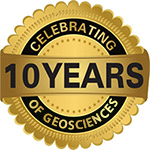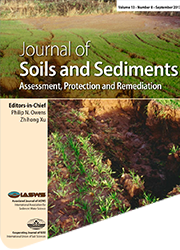 Mark your calendar for the most comprehensive geosciences event particularly focused on understanding the geologic, geophysical, environmental and climatic evolution of the Arabian Peninsula, North Africa and Earth’s Arid and Semi-Arid areas. In general, the Conference Scientific Committee invites research papers on all cross-cutting themes of Earth sciences from all regions of the world, principally focusing on 10 major themes (see Conference Tracks).
Mark your calendar for the most comprehensive geosciences event particularly focused on understanding the geologic, geophysical, environmental and climatic evolution of the Arabian Peninsula, North Africa and Earth’s Arid and Semi-Arid areas. In general, the Conference Scientific Committee invites research papers on all cross-cutting themes of Earth sciences from all regions of the world, principally focusing on 10 major themes (see Conference Tracks). 
AIMS & SCOPE

The Arabian Journal of Geosciences (AJG)
is a Springer journal publishing original articles on the entire range of Earth sciences in partnership with the Saudi Society for Geosciences.
The journal focuses on, but not limited to, research themes which have regional significance to the Middle East, the Euro-Mediterranean, Africa and Asia.
The journal receives on average 2000 submissions a year and accepts around 500 papers for publication in its 24 annual issues (acceptance rate 25%).
It enjoys the participation of an editorial team of 100 international Associate Editors who generously help in evaluating and selecting the best papers.

In 2008, Prof. Abdullah Al-Amri, in close partnership with Springer,
founded the Arabian Journal of Geosciences (AJGS).
In this year, the journal celebrates its 10th anniversary. On this occasion and to mark this event,
the founder and Editor-in-Chief of the AJGS organizes in close collaboration with Springer the 1st Conference of
the Arabian Journal of Geosciences (1st CAJG). The conference will be an occasion to endorse the
journal’s long-held reputation for bringing together leading authors from the Middle East,
the Euro-Mediterranean, Africa and Asia who work at the wide-ranging fields of Earth sciences.
The dynamic four-day conference will provide attendees with opportunities to share their latest
unpublished findings and learn the newest geosciences studies. The event will also allow attendees
to meet and discuss with the journal’s editors and reviewers.

125 years since the discovery of the Tethyan Sea… In 1893, the Austrian
geologist Eduard Suess (1831-1914)
proposed the theory that an ancient and extinct inland sea had once existed between Laurasia and the continents
which formed Gondwana, before the opening of the Indian and Atlantic oceans during the Cretaceous period.
He named it the 'Tethys Sea' after the Greek sea goddess Tethys. He provided evidence for his theory using
fossil records from the Alps and Africa. He proposed the concept of Tethys in his four-volume work Das Antlitz
der Erde (The Face of the Earth). The latest successor of the Tethyan Sea is the present Mediterranean Sea. Eduard Suess is
one of the greatest geologists of all time and he is probably the greatest geologist who ever lived.
The year 2014 was devoted to his memory by the international geosciences community. This year marks 125 years
since his discovery of the Tethyan Sea. To celebrate this event, the 1st CAJG will devote a special session
and a keynote lecture by Prof. Celâl Sengör to the life and work of Eduard Suess who was not only a great scientist,
but with many merits as an applied geologist!
CONFERENCE TRACKS
The scientific committee of the 1st CAJG invites research papers on all cross-cutting themes of Earth sciences, principally focusing on the following 10 conference tracks:
- Track 1. Climate, paleoclimate and paleoenvironmental changes
- Track 2. Geo-informatics, remote sensing, geodesy
- Track 3. Geoenvironmental engineering, geomechanics and geotechnics, geohazards
- Track 4. Geography, geoecology, geoarcheology, geotourism
- Track 5. Geophysics, seismology
- Track 6. Hydrology, hydrogeology, hydrochemistry
- Track 7. Mineralogy, geochemistry, petrology and volcanology
- Track 8. Petroleum engineering and petroleum geochemistry
- Track 9. Sedimentology, stratigraphy, paleontology, geomorphology, pedology
- Track 10. Structural / petroleum / mining geology, geodynamics, marine geology
ABOUT CAJG
PARTNERED JOURNALS

Arabian Journal of Geosciences
(Impact Factor = 0.955)

Journal of Soils and Sediments
(Impact Factor = 2.522)

International Journal of Earth Sciences
(Impact Factor = 2.283)

Environmental Earth Sciences
(Impact Factor = 1.569)
(Impact Factor = 1.569)

Journal of Petroleum Exploration and Production Technology
(indexed in ISI's ESCI)

Euro-Mediterranean Journal for Environmental Integration

Earth Systems and Environment

Applied Water Science
(indexed in ISI's ESCI)
(indexed in ISI's ESCI)

Innovative Infrastructure Solutions
(indexed in ISI's ESCI)
(indexed in ISI's ESCI)














